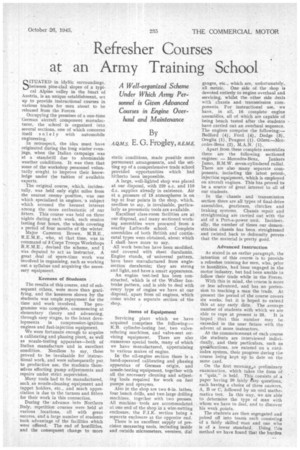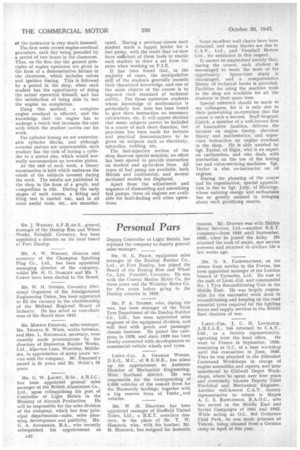Refresher Courses at an Army Training School •
Page 33

Page 34

If you've noticed an error in this article please click here to report it so we can fix it.
SITUATED in idyllic surroundings, between pine-clad slopes of a typical Alpine valley in the heart of Austria, is an unique establishment, set up to provide instructional courses in various trades for men about to be released from the Forces.
Occupying the premises of a one-time German aircraft component manufacturer, the school is organized into several sections, one of which concerns itself solely with automobile engineering.
In retrospect, the idea must have originated during the long winter evenings, when the Italian campaign was at a standstill due to abominable weather conditions. It was then that some of the workshop personnel voluntarily sought to improve their knowledge under the tuition of available experts.
The original course, which, incidentally, was held only eight miles from the nearest enemy position, was one which specialized in engines, a subject which aroused the keenest interest among the more enthusiastic of our fitters. This course was held on three nights during each week, each session lasting four hours, the whole covering a period of four months of the winter.
Major Cameron Brown, M.B.E., R.E.M.E., who, at that time, was in command of 5 Corps Troops Workshops R.E.M.E., devised the scheme, and I was deputed to act as instructor. A great deal of spare-time work was involved in organizing, such as working out a syllabus and acquiring the necessary equipment.
Keeness of Students The results of this course, and of subsequent others, were more than gratifying, and the keenness shown by the students was ample repayment for the time and work involved. The programme was complete, commencing at elementary theory and advancing, through easy stages, to the latest developments in compression-ignition engines and fuel-injection equipment.
We were fortunate enough to acquire a calibrating and phasing plant, as well as nozzle-testing apparatus—both of Italian manufacture and in excellent condition. Needless to say, these proved to be invaluable for instructional work, and were subsequently put to productive use, the students themselves effecting pump adjustments and repairs under strict supervision.
Many tools had to be manufactured, such as nozzle-cleaning equipment and tappet holders, etc., and much appreciation is due to the turners and fitters for their work in this connection.
During the• advance into Northern Italy, repetition courses were held at various locations, all with great success, and a large number of students took advantage of the facilities which were offered. The end of hostilities, and the consequent change to more static conditions, made possible more permanent arrangements, and the setting up of a comprehensive trade school provided opportunities which had hitherto been impossible. A large, well-lighted shop was placed at our disposal, with 220 a.c. and 110 d.c. supplies already in existence. Air at a pressure of 15 atmospheres is on tap at four points in the shop, which, needless to say, is invaluable, particularly as pneumatic tools are available.
Excellent class-roam facilities are at our disposal, and many sectioned working assemblies were procured from a nearby Luftwaffe school. Complete assemblies of both British and continental types were obtained, about which I shall have more to say.
All work benches have been modified, and covered with sheet duralumin. Engine stands, of universal pattern, have been manufactured from angleSection duralumin; they are strong and light, and have a smart appearance.
An engine test-bed has been constructed, which is of the Walker fanbrake pattern, and is able to deal with every type of engine we have at our disposal, apart from oil engines, which come under a separate section of the shop.
Items of Equipment Servicing plant which we have acquired comprises the following:— KB. cylinder-boring bar, two valverefacing machines, and valve-seat servicing equipment. There are also numerous special tools, many of which we have manufactured, aPpertaining to various makes of engine.
In the oil-engine section there is a hand-operated calibrating and phasing apparatus of German origin, and nozzle-testing equipment, together with all the necessary cleaning and adjusting tools required for work on fuel pumps and sprayers.
Also in the shop are two 6-in, lathes, four bench drills, and two large drilling machines, together with two presses. All machine tools are accommodated at one end of the shop in a wire-netting enclosure, the FIE. section being a separate enclosure at the opposite end. There is an excellent supply of precision measuring tools, including inside and outside micrometers, verifiers, dial gauges, etc., which are, unfortunately. all metric. One side of the shop is devoted entirely to engine overhaul and servicing, whilst the other side deals with chassis and transmission components. For instructional use, we have, in all, 16 complete engine assemblies, all of which are capable of being bench tested after the students have carried out an overhaul sequence. The engines comprise the following:— Bedford (4), Ford (4), Dodge (3), Oreglia (1) , Peugeot (1). Offers:—Mercedes-Benz (2), M.A.N. (I).
Apart from these complete assemblies there are the following sectioned engines: — Mercedes-Benz, Junkers Jumo, seven-cylindered radial.
There are also many separate components, including the latest petrol-. injection equipment, which is employed on aircraft engines. This has proved to be a source of great interest to all of our students.
In the chassis and transmission section there are all types of final-drive assemblies, gearboxes, clutches and braking systems. Chassis repair and straightening are carried out with the aid of a Port-a-power unit. Incidentally, the number of times our demonstration chassis has been straightened and twisted back to deformity proves that the material is pretty good.
Advanced Instruction As stated in an earlier paragraph, the intention of this course is to provide a refresher training for men, who, prior to hostilities, had been engaged in the motor industry, but had been unable to follow their trade while in the Forces.
With this in mind, the course is more or less advanced, and has no pretension to teaching a man the trade. At present the period of the course covers six weeks, but it is hoped to extend this at any early date. The average number of students with which we are able to cope at present is 25. It is hoped that this number may be exceeded in the near future with the advent of more instructors.
At the commencement of each course the students are interviewed individually, and their particulars, such as qualifications, are entered on a cardindex system, their progress during the . course being kept up to date on the same card.
On the first morning„a preliminary examination, which takes the form of a "quiz," is held. This consists of a paper having 20 fairly easy questions, each having a choice of three answers, A, B or C, followed by an oral mathematics test. In this way, we are able to determine the type of man with whom we have to deal, and to discover his weak points.
The students are then segregated and paired off into teams each consisting of a fairly skilled man and one who is of a lower standard. Using this method we have found that the burden of the instructor is very much lessened.
The first week covers engine-overhaul procedure, each day being preceded by a period of two hours in the classroom. Thus, on the first day the general principles of engine operation are given in the form of a demonstrative lecture in the classroom, which includes valves and ignition timing. This is followed by a period in the shop, when each student has the opportunity of doing the actual operation himself, and has the satisfaction of being able to test the engine on completion.
Using this method, a complete engine overhaul is effected, and the knowledge that the engine has to undergo a bench test increases the care with which the student carries out his work.
For cylinder boring we use unserviceable cylinder blocks, and although oversize pistons are unprocurable, each student has the task of boring a cylinder to a stated size, which would normally accommodate an oversize piston.
At the end of each week, a theory examination is held which embraces the -whole of the subjects covered during the week. The results are published in the shop in the form of a graph, and competition is rife. During the early stages of each course, a fitting and filing test is carried out, and in all cases useful tools, etc., are manufac
tured. During a previous course each student made a tappet holder for a fuel pump, with the result that we now have sufficient of these tools to enable each student to draw a set from the store when working on F.I.E.
It has been found that, in the majority of cases, the manipulative skill of the students generally exceeds their theoretical knowledge, and one of the main objects of the course is to improve their standard of technical ability. For those numerous students whose knowledge of mathematics is particularly low, time has been found to give them instruction on necessary calculations, etc. It will appear obvious that many subjects cannot be included in a course of such short duration, but provision has been made for lectures and practical demonstrations to be given on subjects such as--electricity, epicyclics, welding, etc.
The fuel-injection section of the shop deserves special mention; no effort has been spared to provide instruction on modern and up-to-date lines. All types of fuel pump are available, both British and continental,, and several sectioned models are displayed.
Apart from the adjustment and sequence of dismantling and assembling fuel pumps, three oil engines are available for fault-finding and other operations.
Some excellent wall charts have been obtained, and many thanks are due to C.A.V., Ltd., and Vauxhall Motors Ltd., for assistance in this respect.
It cannot be emphasized unduly that, during the course, each student is encouraged to make the most of his opportunity. Spare-time study is encouraged, and a comprehensive library of technical books is provided. Facilities for using the machine tools in the shop are available for all the students in their spare time.
Special reference should be made to my colleagues, for it is only due to their painstaking co-operation that the course is such a success. Staff-Sergeant Cusick, a Member of a well-known firm of Lancashire hauliers, delivers the lectures on engine theory, electrical theory and mathematics, and supervizes instruction on engine overhaul in the shop. He is ably, assisted by Sgt. Taylor, of Elgin, who is an expert on carburation, and who deals with instruction on the use of the boring bar and valve-servicing machines. Sgt. Taylor is also co-instructor on oil engines.
During the planning of the course and its organization, special appreciation is due to Sgt. Jolly, of Hastings, whose untiring energy and enthusiasm has so greatly assisted in bringing about such gratifying results.




















































